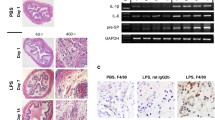Abstract
The bacterial extract, Uro-Vaxom®, which consists of immunostimulating components derived from 18 Escherichia coli strains, was used for the prophylaxis of recurrent cystitis. To evaluate the anti-inflammatory effect of E. coli extract, we measured the cytokine levels of bladder tissue after oral administration and analyzed bladder inflammation by histopathologic examination in a model of lipopolysaccharide (LPS)-induced cystitis in mice. After oral administering the E. coli extract for 10 days, the cytokine [interleukin-6 (IL-6), IL-10, monocyte chemoattractant protein-1, interferon-γ (IFN-γ), tumor necrosis factor-α, IL-12p70] levels present in the bladder of female Balb/C mice were determined using a cytometric bead array. The bladder macrophage inflammatory protein-2 level was also measured using a sandwich enzyme immunoassay. After immunization with the E. coli extract, E. coli LPS was instilled into the bladders intravesically. Twenty-four hours later, the mice were sacrificed and the level of bladder inflammation was quantified using the bladder inflammatory index (BII). Significant changes in the bladder IL-6 and IFN-γ levels were observed after the E. coli extract treatment. Secretions of the other cytokines were not stimulated by the E. coli extract. The bladder instilled with LPS had high inflammation scores for edema, leukocyte infiltration, and hemorrhage in the saline treated control mice. In contrast, the E. coli extract treated mice exhibited mild inflammation of their bladders with a significant reduction in the BII scores compared with the controls. These findings might explain the anti-inflammatory effect of the E. coli extract demonstrated in clinical studies.



Similar content being viewed by others
References
Sobel JD (1991) Bacterial etiologic agents in the pathogenesis of urinary tract infection. Med Clin North Am 75:253–273
Hooton TM, Scholes D, Hughes JP et al (1996) A prospective study of risk factors for symptomatic urinary tract infection in young women. N Engl J Med 335:468–474
Stamm WE, Hooton TM (1993) Management of urinary tract infections in adults. N Engl J Med 329:1328–1334
Foxman B (1990) Recurring urinary tract infection: incidence and risk factors. Am J Public Health 80:331–333
Bauer HW, Rahlfs VW, Lauener PA, Blessmann GS (2002) Prevention of recurrent urinary tract infections with immuno-active E. coli fractions: a meta-analysis of five placebo-controlled double-blind studies. Int J Antimicrob Agents 19:451–456
Frey C, Obolensky W, Wyss H (1986) Treatment of recurrent urinary tract infections: efficacy of an orally administered biological response modifier. Urol Int 41:444–446
Hachen HJ (1990) Oral immunotherapy in paraplegic patients with chronic urinary tract infections: a double-blind, placebo-controlled trial. J Urol 143:759–763
Schulman CC, Corbusier A, Michiels H, Taenzer HJ (1993) Oral immunotherapy of recurrent urinary tract infections: a double-blind placebo-controlled multicenter study. J Urol 150:917–921
Magasi P, Panovics J, Illes A, Nagy M (1994) Uro-Vaxom and the management of recurrent urinary tract infection in adults: a randomized multicenter double-blind trial. Eur Urol 26:137–140
Lettgen B (1996) Prevention of recurrent urinary tract infections in female children. Curr Ther Res 57:464–475
Wybran J, Libin M, Schandene L (1989) Enhancement of cytokine production and natural killer activity by an Escherichia coli extract. Onkologie 3(Suppl 12):22–25
Hockertz S (1990) Immunomodulatory effect of lysed immunoactive fractions of selected Escherichia coli strains on the macrophage system. An in vitro study. Arzneimittelforschung 40:1068–1072
Van Pham T, Kreis B, Corradin-Betz S, Bauer J, Mauel J (1990) Metabolic and functional stimulation of lymphocytes and macrophages by an Escherichia coli extract (OM-89): in vitro studies. J Biol Response Mod 9:231–240
Bessler WG, Kleine B, Martinez Alonso C et al (1990) Biological activity of bacterial surface components: bacterial extracts and defined bacterial cell wall components as immunomodulators. Lung 168(Suppl):707–715
Bessler WG, Beck P, Konetznick U et al (1991) Biological activity of bacterial surface components. Immunogenicity and immunomodulatory properties of a bacterial extract from Escherichia coli. Arzneimittelforschung 41:274–279
Huber M, Baier W, Serr A, Bessler WG (2000) Immunogenicity of an E. coli extract after oral or intraperitoneal administration: induction of antibodies against pathogenic bacterial strains. Int J Immunopharmacol 22:57–68
Sedelmeier EA, Bessler WG (1995) Biological activity of bacterial cell-wall components: immunogenicity of the bacterial extract OM-89. Immunopharmacology 29:29–36
Raetz CR (1993) Bacterial endotoxins: extraordinary lipids that activate eucaryotic signal transduction. J Bacteriol 175:5745–5753
Dupont MC, Spitsbergen JM, Kim KB, Tuttle JB, Steers WD (2001) Histological and neurotrophic changes triggered by varying models of bladder inflammation. J Urol 166:1111–1118
Jerde TJ, Bjorling DE, Steinberg H, Warner T, Saban R (2000) Determination of mouse bladder inflammatory response to E. coli lipopolysaccharide. Urol Res 28:269–273
Cook EB, Stahl JL, Lowe L et al (2001) Simultaneous measurement of six cytokines in a single of human tears using microparticle-based flow cytometry: allergics vs. non-allergics. J Immunol Methods 254:109–118
Wolpe SD, Cerami A (1989) Macrophage inflammatory proteins 1 and 2: members of a novel superfamily of cytokines. FASEB J 3:2565–2573
Olson NC, Hellyer PW, Dodam JR (1995) Mediators and vascular effects in response to endotoxin. Br Vet J 151:489–522
Hooton TM (2001) Recurrent urinary tract infection in women. Int J Antimicrob Agents 17:259–268
Stamm WE, McKevitt M, Roberts PL, White NJ (1991) Natural history of recurrent urinary infections in women. Rev Infect Dis 13:77–84
Author information
Authors and Affiliations
Corresponding author
Rights and permissions
About this article
Cite this article
Lee, SJ., Kim, S.W., Cho, YH. et al. Anti-inflammatory effect of an Escherichia coli extract in a mouse model of lipopolysaccharide-induced cystitis. World J Urol 24, 33–38 (2006). https://doi.org/10.1007/s00345-005-0046-y
Received:
Accepted:
Published:
Issue Date:
DOI: https://doi.org/10.1007/s00345-005-0046-y




